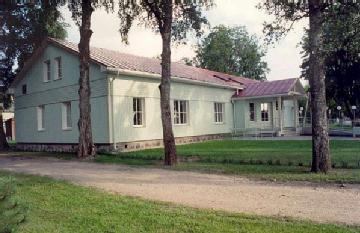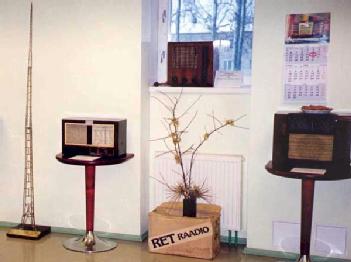| Description
|
Collections
The archival collection consists predominantly of books, periodicals, manuscripts and documents about the history of radio and television, the history of the manufacture of radio and television sets, and the history of listening to radio and watching television.
The equipment collection consists of radio and television sets, accessories to receivers, studio, transmission and reporter equipment, and devices for manufacturing receivers by factories, workshops and amateurs.
The technical side of broadcasting attracts the most international interest, as most of the equipment was obtained from abroad. The collection in the Museum includes studio equipment imported from England, Germany, Hungary, etc, and radio receiving sets imported from Holland, England, Germany, etc.
The memento collection is quite distinctive assembly of souvenirs and awards relating to broadcasting organisations, events, and reporters.
The photo collection consists principally of photographic materials, depicting the history of radio, television, and domestic radio manufacturing. This collection also includes photographs depicting broadcasting coverage, the continuation of broadcasting history and the activities of the Broadcasting Museum.
The audio-video collection consists of recordings of the memoirs of people who have played a significant role in the history of broadcasting. The recordings of the events organised by the Museum have been included in the audio-video collection.
The Museum’s activities were launched on a systematic basis in November 1999. The first exhibition was held In December 1999. The Museum then moved, in 2000, to the current permanent location in a building freshly renovated by the local municipality. The first permanent exhibition was opened to the general public on the 18 December 2001 which was 75th anniversary of the Estonian national broadcasting (18 December 1926).
Permanent Exhibition
The Permanent Exhibition is divided into three distinct sections:
The 1926-1944 section exhibits items and materials from the early period of broadcasting when a private venture that began in a three-room down-town apartment in Tallinn developed into a national broadcasting company; the studios, transmission stations, and programming of which met all contemporary European standards. Exhibits include wax-statues of Felix Moor, the “radio-man”, and Fred Olbrei, the then director of the State Broadcasting Company, models of a carbon and capacitor microphone, a gramophone record cutter, and a scale model (1:75) of the Türi radio transmitting station. Photo stands introduce the radio personnel of that period and the equipment, which was destroyed during WW2. The visitor can also examine the radio-sets, which reflect the standard of radio manufacturing in the 1930s.
The 1944-1991 section exhibits the broadcasting activities under the Soviet regime. Various portable recorders for reporters, microphones and details from the transmission station at Laitse make up the exhibition in this section.
The Television section has 130 photographs exhibiting the key moments in the 50 years of Estonian national public television – Eesti Televisioon. Book-like text stands provide detailed information about each decade and both about public and private television. The Television sets on exhibition provide a review of the history of watching TV.
There are two particularly interesting exhibits in this section that are the work of Television Engineer, Mati Tähemaa. The first is a reconstructed TV-set with the Nipkow disc, which provides a 30-line television picture (in 1937 there were about 50 such sets in Estonia). The second is a renovated KVN-49 TV-set, originally built in 1955, which has a postcard-size screen which is magnified by a water lens. |
Description
(other) |
Näituse esimeses osas (aastad 1926-1944) eksponeeritakse esemeid ja materjale raadio algusaegadest, mil kolmetoalises korteris tegevust alustanud eraraadiost kujunes välja Euroopa tasemel rahvusringhääling oma stuudiote, saatejaamade ja saatekavaga. Eksponeeritud on "raadioonu" Felix Moori ja Riigi Ringhäälingu direktori Fred Olbrei vahakujud, mulaazaid süsi- ja kondensaatormikrofonidest, 1938.a. plaadilõikaja ja Türi raadiosaatejaama makett (1:75). Fotostendid tutvustavad ringhäälingus töötanud inimesi ja hävinud tehnikat, eksponeeritud vastuvõtjad kodumaise raadiotööstuse arengut neil aastatel.
Näituse teine osa tutvustab raadioringhäälingu tegevust aastatel 1944-2006. Eksponeeritud on mitmesugused reportermagnetofonid, mikrofonid, stuudiote ja saatejaamade seadmed. Taasloodud foonikas on võimalik kuulata magnetlindile salvestatud muusikat ja sõnalisi saateid. Fotostendid tutvustavad tollaseid raadiotegijaid ja eksponeeritud raadiovastuvõtjad raadiotehase “Punane RET” tegevust.
Näituse tele-osas näitab 130 fotost koosnev pildimaterjal hetki Eesti Televisiooni poolsajandist. Tekstiraamatud, milles on teleajaloo iga kümnendi kohta paar lehekülge, lisavad teavet nii ETV kui ka erakanalite ajaloost. Eksponeeritud
televiisorid annavad ülevaate telerivaatamise ajaloost Eestis. Insener Mati Tähemaa ehitatud-korrastatud seadmete abil on näitusel võimalik näha Nipkowi kettaga televiisori 30 realist telepilti (1937. a oli sellised ligikaudu 50) ja 1955. aastal toodetud postkaardi suuruse ekraaniga televiisori KVN-49 vesiluubiga suurendatud telepilti. |


 rhmuuseum.ee
rhmuuseum.ee 


